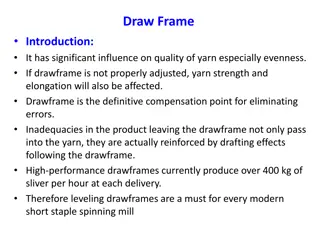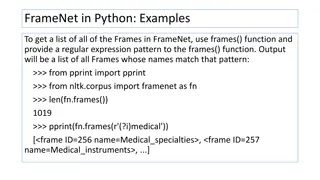Recursion and Stack Frames in Python: Understanding Recursive Functions
The concept of recursion in Python by delving into recursive functions, stack frames, and the interplay between them. Dive into examples and explanations to grasp how recursion works and its significance in programming. Understand how recursive functions call themselves and manage stack frames, leading to a deeper understanding of Python programming fundamentals.
Download Presentation

Please find below an Image/Link to download the presentation.
The content on the website is provided AS IS for your information and personal use only. It may not be sold, licensed, or shared on other websites without obtaining consent from the author.If you encounter any issues during the download, it is possible that the publisher has removed the file from their server.
You are allowed to download the files provided on this website for personal or commercial use, subject to the condition that they are used lawfully. All files are the property of their respective owners.
The content on the website is provided AS IS for your information and personal use only. It may not be sold, licensed, or shared on other websites without obtaining consent from the author.
E N D
Presentation Transcript
Recursion Recursion symbol table stack frames
Recursion Recursion Python shell > def recursive_function(x): if x > 0: print("start", x) recursive_function(x - 1) print("end", x) else: print("done") Recursive function function that calls itself recursive_function(5) end 5 start 5 > recursive_function(5) | start 5 | start 4 | start 3 | start 2 | start 1 | done | end 1 | end 2 | end 3 | end 4 | end 5 recursive_function(4) end 4 start 4 recursive_function(3) end 3 start 3 recursive_function(2) end 2 start 2 recursive_function(1) end 1 start 1 recursive_function(0) done
Recursion Recursion Python shell > def recursive_function(x): if x > 0: print("start", x) recursive_function(x - 1) print("end", x) else: print("done") x 0 stack frame x 1 > recursive_function(5) | start 5 | start 4 | start 3 | start 2 | start 1 | done | end 1 | end 2 | end 3 | end 4 | end 5 x 2 x 3 x 4 x 5 recursive_function <function> global variables Recursion stack when x = 0 is reached
Python shell > def rec(x): if x > 0: Python shell > rec(3) | start 3 | start 2 | start 1 | done | done | end 1 | start 1 | done | done | end 1 | end 2 | start 2 | start 1 | done | done | end 1 | start 1 | done | done | end 1 | end 2 | end 3 print("start", x) rec(x - 1) rec(x - 1) print("end", x) else: print("done") Recursion tree rec(3) rec(2) rec(2) rec(1) rec(1) rec(1) rec(1) rec(0) rec(0) rec(0) rec(0) rec(0) rec(0) rec(0) rec(0)
does rec(5)print print done ? Question Question How How many many times times does ? a) 3 b) 5 c) 15 d) 81 e) 125 f) 243 g) Don t know Python shell > def rec(x): if x > 0: print("start", x) rec(x - 1) rec(x - 1) rec(x 1) print("end", x) else: print("done") = 35
Factorial Factorial n ! = n (n - 1) (n - 2) 3 2 1 (n 1) ! Observation 1 ! = 1 n ! = n (n - 1) ! (recursive definition) factorial.py def factorial(n): if n <= 1: return 1 return n * factorial(n - 1) factorial_iterative.py def factorial(n): result = 1 for i in range(2, n + 1): result *= i return result factorial.py def factorial(n): return n * factorial(n - 1) if n > 1 else 1
n k Binomial Binomial coefficient coefficient n k = number of ways to pick k elements from a set of size n 1 +n 1 k 1 if k = 0 or k = n n k= n 1 k otherwise binomial_recursive.py def binomial(n, k): if k == 0 or k == n: return 1 return binomial(n - 1, k) + binomial(n - 1, k - 1) Unfolding computation shows n 1 s are added slow k
Readable functions ? Readable functions ? return early / bail out fast return early / bail out fast binomial_return_early.py Treat simple cases first and return Do not put else after if ending with return Avoid unnecessary nesting of code 1-liners are not always the most readable code def binomial(n, k): # Ugly, nested indentations and redundant else if k == 0: return 1 else: if k == n: return 1 else: return binomial(n - 1, k) + binomial(n - 1, k - 1) def binomial(n, k): # Treat each special case first and return if k == 0: return 1 if k == n: return 1 return binomial(n - 1, k) + binomial(n - 1, k - 1) def binomial(n, k): # Several cases simultaneously is test obvious? if k == 0 or k == n: return 1 return binomial(n - 1, k) + binomial(n - 1, k - 1) def binomial(n, k): # 1-liner, but is this the easiest to read? return binomial(n - 1, k) + binomial(n - 1, k - 1) if 0 < k < n else 1 See also Clean Code - Handbook of Agile Software Craftsmanship, by Robert C Martin (2009)
Python shell Tracing Tracing the the recursion recursion > binomial(4, 2) | binomial(4, 2) | binomial(3, 2) | binomial(2, 2) | return 1 | binomial(2, 1) | | | | | return 2 | return 3 | binomial(3, 1) | binomial(2, 1) | | | | | return 2 | binomial(2, 0) | return 1 | return 3 | return 6 | 6 At beginning of function call, print arguments Before returning, print return value Keep track of recursion depth in a argument to print indentation binomial(1, 1) return 1 binomial(1, 0) return 1 binomial_trace.py def binomial(n, k, indent=0): print(' ' * indent + f'binomial({n}, {k})') if k == 0 or k == n: result = 1 else: result = binomial(n - 1, k, indent=indent + 1) + \ binomial(n - 1, k - 1, indent=indent + 1) print(' ' * indent + f'return {result}') return result binomial(1, 1) return 1 binomial(1, 0) return 1
n k Binomial Binomial coefficient coefficient n k = n ! Observation n k! k ! binomial_factorial.py def binomial(n, k): return factorial(n) // factorial(k) // factorial(n - k) Unfolding computation shows 2n - 2 multiplications and 2 divisions fast Intermediate value n ! can have significantly more digits than result (bad)
n k Binomial Binomial coefficient coefficient n k =n (n 1) (n 2) (n k + 1) k k 1 k 2 1 n = n 1 k 1 Observation k binomial_recursive_product.py def binomial(n, k): if k == 0: return 1 else: return binomial(n - 1, k - 1) * n // k Unfolding computation shows k multiplications and divisions fast Multiplication with fractions 1 intermediate numbers limited size
n k ? ? Questions Questions Which Which correctly correctly computes computes n k =n (n 1) (n 2) (n k + 1) k k 1 k 2 1 Observation Python shell > binomial_A(5, 2) | 8 > binomial_B(5, 2) | 10 binomial_iterative.py def binomial_A(n, k): result = 1 for i in range(k): result = result * (n - i) // (k - i) return result a) binomial_A b) binomial_B c) both d) none e) Don t know def binomial_B(n, k): result = 1 for i in range(k)[::-1]: result = result * (n - i) // (k - i) return result
Recursively print all leaves of a tree Recursively print all leaves of a tree Assume a recursively nested tuple represents a tree with strings as leaves Python shell > def print_leaves(tree): if isinstance(tree, str): print('Leaf:', tree) else: for child in tree: print_leaves(child) /\ / \ 'a' /\ > print_leaves(('a',('b','c'))) | Leaf: a | Leaf: b | Leaf: c / \ 'b' 'c'
Question Question How many times is How many times is print_leaves function called in the example? function called in the example? Python shell > def print_leaves(tree): if isinstance(tree, str): print('Leaf:', tree) else: for child in tree: print_leaves(child) a) 3 b) 4 c) 5 d) 6 e) Don t know /\ / \ 'a' /\ > print_leaves(('a',('b','c'))) | Leaf: a | Leaf: b | Leaf: c / \ 'b' 'c'
Python shell > def collect_leaves_wrong(tree, leaves = set()): if isinstance(tree, str): leaves.add(tree) else: for child in tree: collect_leaves_wrong(child, leaves) return leaves > collect_leaves_wrong(('a',('b','c'))) | {'a', 'c', 'b'} > collect_leaves_wrong(('d',('e','f'))) | {'b', 'e', 'a', 'f', 'c', 'd'} > def collect_leaves_right(tree, leaves = None): if leaves == None: leaves = set() if isinstance(tree, str): leaves.add(tree) else: for child in tree: collect_leaves_right(child, leaves) return leaves > collect_leaves_right(('a',('b','c'))) | {'b', 'a', 'c'} > collect_leaves_right(('d',('e','f'))) | {'f', 'd', 'e'}
Python shell > def collect_leaves(tree): leaves = set() def traverse(tree): nonlocal leaves # can be omitted if isinstance(tree, str): leaves.add(tree) else: for child in tree: traverse(child) traverse(tree) return leaves > collect_leaves(('a', ('b', 'c'))) | {'b', 'a', 'c'} > collect_leaves(('d', ('e', 'f'))) | {'f', 'd', 'e'}
Maximum Maximum recursion recursion depth depth ? ? Python shell > def f(x): print("#", x) f(x + 1) Pythons maximum allowed recursion depth can be increased by > f(1) | # 1 | # 2 | # 3 | ... | # 975 | # 976 | # 977 | # 978 | RecursionError: maximum recursion depth exceeded while pickling an object import sys sys.setrecursionlimit(1500)
Koch Koch Curves Curves koch_curve.py import matplotlib.pyplot as plt from math import sqrt def koch(p, q, depth=3): if depth == 0: return [p, q] depth = 0 p2 depth = 1 (px, py), (qx, qy) = p, q dx, dy = qx - px, qy - py h = 1 / sqrt(12) p1 = px + dx / 3, py + dy / 3 p2 = px + dx / 2 - h * dy, py + dy / 2 + h * dx p3 = px + dx * 2 / 3, py + dy * 2 / 3 return (koch(p, p1, depth - 1)[:-1] + koch(p1, p2, depth - 1)[:-1] + koch(p2, p3, depth - 1)[:-1] + koch(p3, q, depth - 1)) points = koch((0, 0), (1, 0), depth=3) X, Y = zip(*points) plt.subplot(aspect='equal') plt.plot(X, Y, 'r-') plt.plot(X, Y, 'k.') plt.show() p p3 p1 q depth = 2 q depth = 3 p2 remove last point (equal to first point in next recursive call) p3 p1 p depth = 4 en.wikipedia.org/wiki/Koch_snowflake
z_curve.py import matplotlib.pyplot as plt Z Z- -curves curves def z_curve(depth, x0=0, y0=0, x1=1, y1=1): x, y = (x0 + x1) / 2, (y0 + y1) / 2 if depth == 0: return [(x, y)] return [ *z_curve(depth - 1, x0, y0, x, y), *z_curve(depth - 1, x, y0, x1, y), *z_curve(depth - 1, x0, y, x, y1), *z_curve(depth - 1, x, y, x1, y1) ] (x1, y1) (x, y) for depth in range(4): X, Y = zip(*z_curve(depth)) plt.subplot(2, 2, 1 + depth, aspect='equal') plt.title(f'depth {depth}') plt.axis('off') plt.axis([0, 1, 0, 1]) plt.plot( [0,1,1,0,0], [0,0,1,1,0], 'k:', # dash box [0.5,0.5], [0,1], 'k:', # dash vertical [0,1], [0.5,0.5], 'k: , # dash horizontal X, Y, 'k-', # Z-curve X, Y, 'r.', # Z-curve points ) plt.show() (x0, y0) en.wikipedia.org/wiki/Z-order_curve























